
From Wyoming Tales and Trails
This Page: the Dalton Trail to the Yukon, Jack Dalton, The Cariboo Wagon Road in British Columbia. Chilkoot Pass, White Pass.

| From Wyoming Tales and Trails This Page: the Dalton Trail to the Yukon, Jack Dalton, The Cariboo Wagon Road in British Columbia. Chilkoot Pass, White Pass. |
 |
|
|
|
About This Site |
White Pass on Way to the Klonkike. On August 16, 1896, Gold was discovered at Rabbit Creek, later renamed Bonanza Creek, near present-day Dawson, Yukon Territory. By 1897, newspaper coverage of the riches to be discovered in the Yukon was a frequent item in Wyoming newspapers. The Sheridan Post published letters from Wyomingites who had gone to the Yukon, on conditions to be found and the gold strikes they were hoping to find. On August 12, 1897, the Lusk Herald published an entire page devoted to the Klondike. Both of the Laramie papers the Boomerang and the Republican published frequent items on the gold rush, the Republican, November 29, noted that steak when for $2.50 in Dawson City. Even the Burlington Railroad got into the act publishing a pamphlet on the Klondike. Among those from Wyoming who joined the rush was Bonanza, Wyoming, horse herderand future sheriff of Big Horn County Byron F. "Kansas" Wickwire, discussed on a subsequent page. Another was was former murderer, Johnson County Sheriff and cattle detective Frank Canton. At the time of the Gold Rush, Canton was living in Oklahoma. Whether it was a desire for wealth or because things were heating up with a minor scandal in Guthrie (He was indicted for fraudulent accounts as a Deputy United States Marshal and discharged) that drove Canton to Alaska and the Yukon is speculative. Jefferson Randolph "Soapy" Smith moved to Alaska after his criminal enterprises based on bribery in Denver and Creed, Colorado, began to unravel. Smith's gang in Colorado began to fade after the Governor of Colorado brought in the State Militia who aimed two gatling guns at Denver's City Hall to cleanse it from corruption. Others began plans for gaining wealth by providing for the pent up demand for meat other than fish, moose meat, and caribou chuck. With the shortages in Dawson City, ordinary provisions went for very high sums. Rufus Price noted the prices: It is not surprising to learn that necessaries and luxuries of life command very high prices. Flour at times sold as high as £3° for a sack of 59 lb. weight. Oranges and lemons were worth 6s. each. The first eggs to arrive sold at 6s. each. Worst of all calamities, whisky ran short, and saloon keepers charged 4s. 2d. per drink. The first consignment early in May of 2,030 gallons was sold within an hour at £9 per gallon. This supply was consumed within a few days. At a leading restaurant having seats for thirty-two guests, the chef de cuisine received £20 per week, and his qualifications apparently consisted in being ability to fry beefsteak into a leathery consistency and make deadly rolls of hot bread of an elegant yellow colour by liberal use of baking powder. The rental of this canvas structure, 20 ft. by 40 ft., was £190 per month. At the leading gambling house and dance hall bar-tenders received £3 per day, dealers of the games £4 per day, and twelve ladies in attendance £10 per week and 25 per cent, on their sales of drinks and cigars. Next winter there will probably be some reductions in tariff charges of this kind. 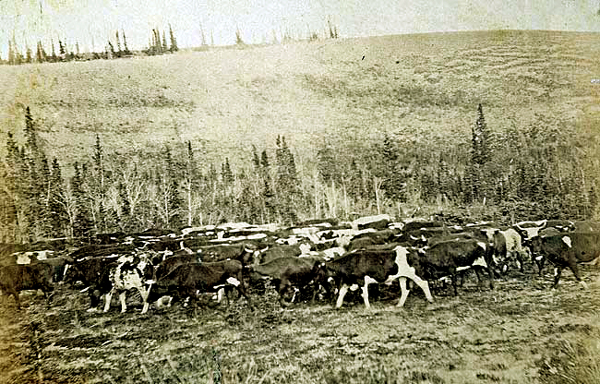 Cattle on the Dalton Trail to the klondike, 1898
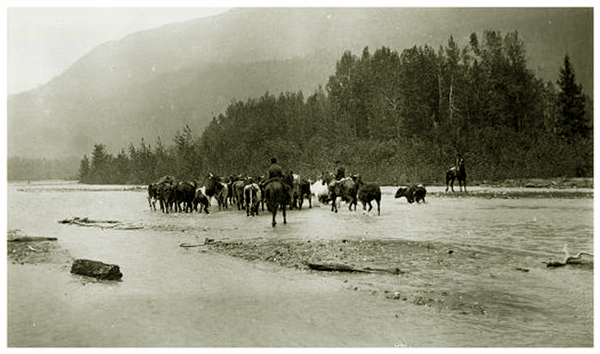 Crossing the Kluhini River, 1898
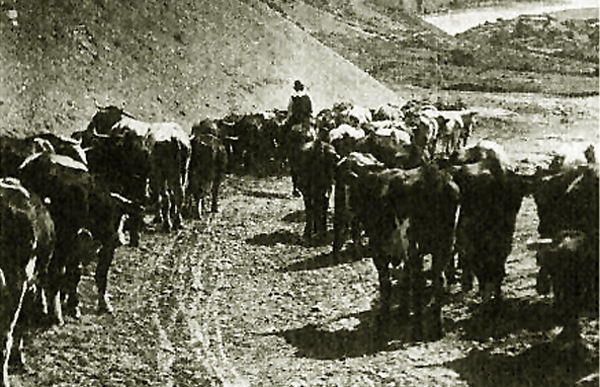 Heading north from British Columbia.
But even earlier during the American Civil War, there was the so-called Cariboo Gold Rush in Briish Columbia after Gold was discovered near Horse Fly Creek. The colonial government consructed at great expense a road northward to Barkerville on which supplies were hauled northward in wagons and on American Army Surplus camels sold when the American Camel Corps was discontinued at the beginning of the American Civil War. Barkerville was where Billy Barker discoveed gold in 1861. Barkerville was the terminus of the Cariboo Wagon Road. At one time, Barkerville was reputedly the largest city noth of San Francisco and west of Chicago. Cattle were driven northward to feed the hungry miners.
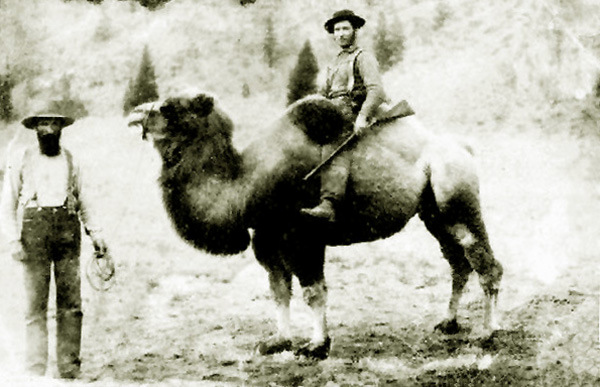 American Army Surplus camel in British Columbia.
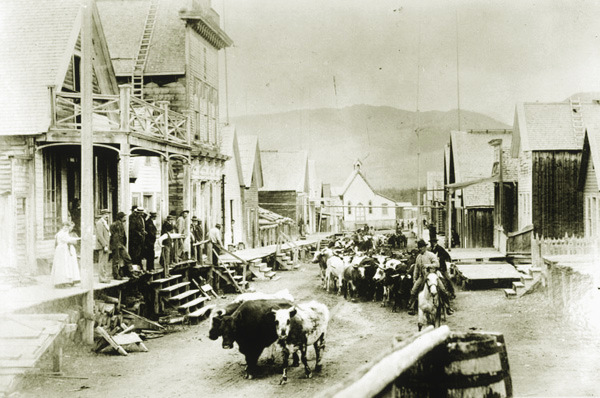 Cattle, Barkerville, B.C., 1880's.
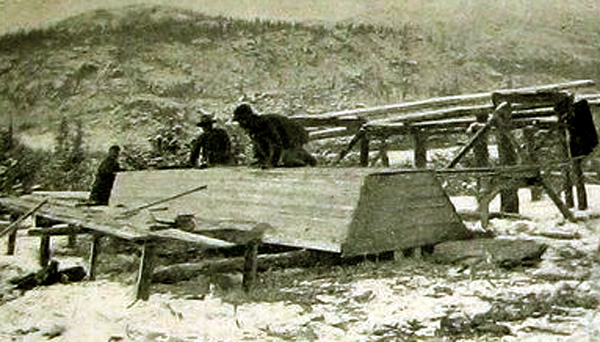 Boat Building along the Yukon River, approx. 1897.
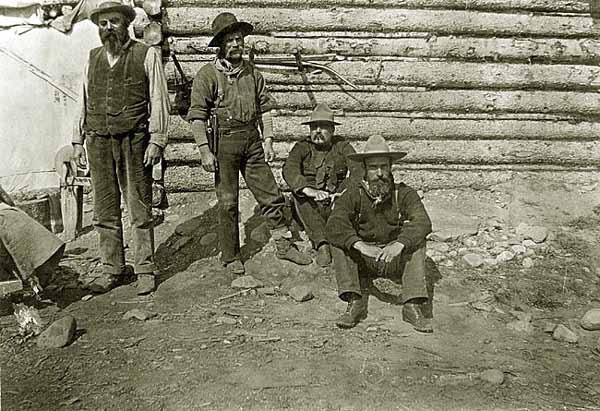 Jack Dalton, 2nd from the left.
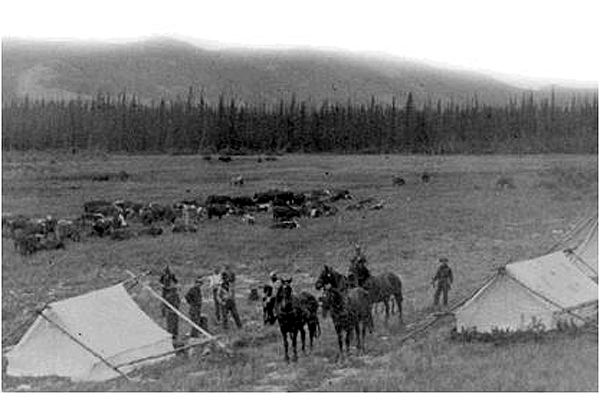 Cattle Herd belonging to Jack Dalton. < An alternative trail was available over White Pass. White Pass was 15 miles longer but the trail over the summit was easier. The American section of the Trail became a toll trail on which Dalton was authorized to charge tolls, $2.50 each for cattle, horses, mules, and burros and fifty cents each for goats, sheep and swine. From there, cattle would be floated down the Yukon River on rafts to Dawson City.But the trail was used for evrything, not just livestock.
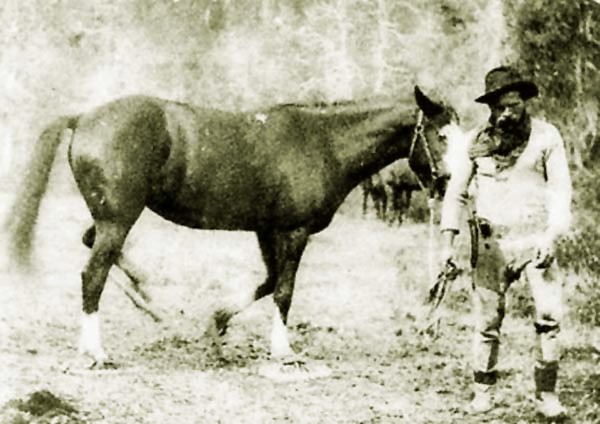 Jack Dalton with horse.
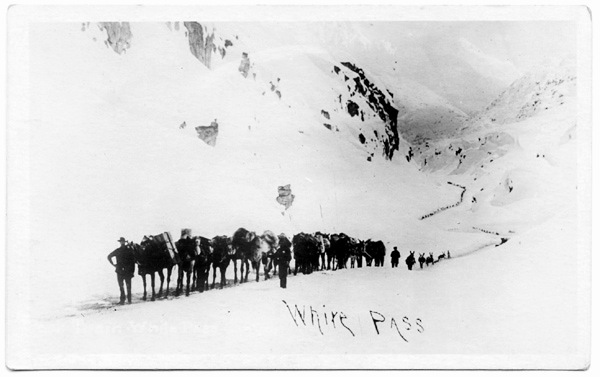 White Pass, approx. 1897.
From Seattle and other points in the south every crazy craft which had been condemned was brought into use again and put on the Skagway route, each of them on arrival unloading hundreds of passengers, large quantities of supplies, mules and horses for packing. The result was that the trail was soon jammed and further progress well nigh impossible. Rain fell in torrents for several weeks, making the trails knee deep in mud; oats and hay became scarce, horses and mules to the number of 3,000 died from ill-usage and starvation, choking the trail with their carcases, and many men became discouraged and returned home.Jack London was less kind in his description of the White Pass Trail: Freighting an outfit over the White Pass in '97 broke many a man's heart, for there was a world of reason when they gave that trail its name. The horses died like mosquitoes in the first frost, and from Skaguay to Bennett they rotted in heaps. They died at the Rocks, they were poisoned at the Summit, and they starved at the Lakes; they fell off the trail, what there was of it, or they went through it; in the river they drowned under their loads, or were smashed to pieces against the boulders; they snapped their legs in the crevices and broke their backs falling backwards with their packs; in the sloughs they sank from sight or smothered in the slime, and they were disembowelled in the bogs where the corduroy logs turned end up in the mud; men shot them, worked them to death, and when they were gone, went back to the beach and bought more. Some did not bother to shoot them, — stripping the saddles off and the shoes and leaving them where they fell. Their hearts turned to stone — those which did not break — and they became beasts, the men on Dead Horse Trail.
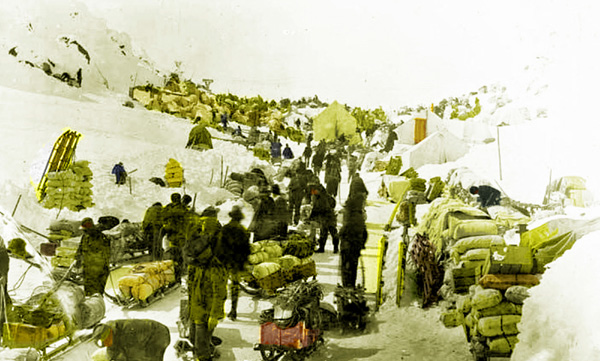 Her Majesty's Customs House, Head of Chilikoot Pass, 1898. Artwork by G. B. Dobson, based on photograph.
Music this Page:
CARIBOO DRIVERS' SONG CHORUS:
Writer's notes: Quesnel, the commercial center of the Cariboo Mining District. Clinton, the site of a dance and rodeo held in May. Originally called "47 Mile," the distance from Lillooet. Next Page, The Trail to the Yukon continued
|

